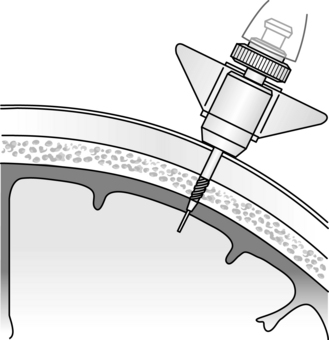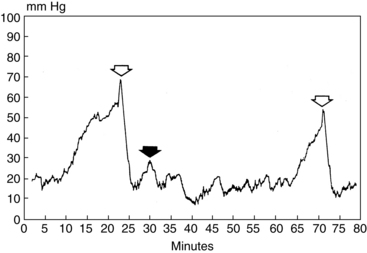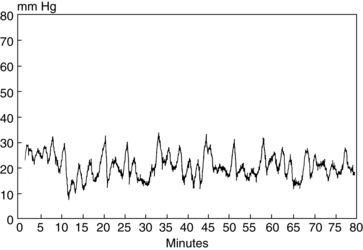PROCEDURE 88 • A fundamental understanding of neuroanatomy and physiology is needed. • Knowledge of aseptic and sterile technique is necessary. • Proper equipment assembly and setup specific to the fiberoptic intracranial pressure monitoring device must be understood. • Intracranial pressure (ICP) is the pressure exerted by the intracranial contents, brain tissue, blood and cerebrospinal fluid (CSF). Increased intracranial pressure occurs when the intracranial volume exceeds the brain’s ability to compensate for increased volume.13 • Normal ICP ranges from 0 to 15 mm Hg; sustained ICPs of greater than 20 mm Hg are generally considered neurologic emergencies.3,10 • ICP is measured via a catheter inserted into the brain parenchyma. The catheter is inserted through an intracranial bolt (Fig. 88-1). • The normal ICP waveform has three or four peaks with P1 of greater amplitude than P2 and P3. P1 is thought to reflect arterial pressure; P2 and P3 and P4 (when present) have been described as choroid plexus or venous in origin (Fig. 88-2).13 The amplitude of P2 may exceed P1 with increased ICP or decreased intracranial compliance (Fig. 88-3). Figure 88-3 Example of intracranial pressure waveforms with P2 elevation indicating decreased cerebral compliance. • ICP waveform trends include a, b, and c waves. The a waves, also referred to as plateau waves, are associated with ICP values of 50 to 100 mm Hg and last 5 to 20 minutes. The a waves (Fig. 88-4) are associated with abrupt neurologic deterioration and herniation. The b waves (Fig 88-5), with ICP values of 20 to 50 mm Hg and lasting 30 seconds to 2 minutes, may become a waves. The c waves (Fig. 88-6) may coincide with ICPs as high as 20 mm Hg but are short lasting and without clinical significance.1 • Cerebral perfusion pressure (CPP) is the pressure at which the brain is perfused. CPP is calculated by subtracting the ICP from the mean arterial pressure (MAP). Normal CPP is thought to be approximately 80 mm Hg.11 In severe traumatic brain injury, the CPP for adults should range between 50 and 70 mm Hg.2 Patients with other neurologic injuries may require individualized CPP parameters reflective of the neuropathology and brain perfusion needs. Research continues regarding the relationship between cerebral blood flow and CPP. • ICP and CPP must be considered together in management of the patient. Cerebral autoregulation is the intrinsic ability of the cerebral vessels to constrict and dilate as needed to maintain adequate cerebral perfusion. Cerebral autoregulation is impaired with brain injury and the cerebral blood flow becomes passively dependent on the systemic blood pressure. The cerebral blood vessels are no longer able to react to maintain CPP in response to a change in blood pressure.3
Intracranial Bolt and Fiberoptic Catheter Insertion (Assist), Intracranial Pressure Monitoring, Care, Troubleshooting, and Removal
PREREQUISITE NURSING KNOWLEDGE

![]()
Stay updated, free articles. Join our Telegram channel

Full access? Get Clinical Tree


88: Intracranial Bolt and Fiberoptic Catheter Insertion (Assist), Intracranial Pressure Monitoring, Care, Troubleshooting, and Removal





